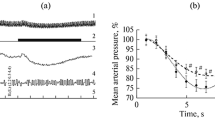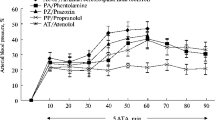Abstract
Studies of the cardiac orienting reflex in 16 dogs, moderately anesthetized and awake are reported. In the anesthetized dogs prominent transient heart rate decrease was commonly noted within one or two beats after the onset of various auditory stimuli, and less often after visual stimuli. This cardiac inhibition was neither as prominent nor as frequent in occurrence in awake dogs. The respiratory cycle at stimulus onset influenced the appearance and degree of heart rate decrease, with the greatest and most frequent decreases occurring during the expiratory phase. Atropine abolished the response. There was little evidence of habituation of this orienting response under anesthesia, although “waxing” and “waning” apparently related to minute-by-minute fluctuations in degree of unconsciousness, occurred. These findings are discussed in relation to neurophysiological and neuroanatomical correlates of orienting responses, hypotheses of orienting and attention and cardiovascular neurohumoral mediators.
Similar content being viewed by others
References
Arduini, A., and Arduini, M. G.: Effect of drugs and metabolic alterations on brain stem arousal mechanisms.J. Pharm. Exp. Therap.,110: 76, 1954.
Brazier, M. A. B.: The action of anesthetics on the nervous system, with special reference to the brain stem reticular system.In J. F. Delafresnaye, ed.,Brain Mechanisms and Consciousness, Springfield, Ill., C. C Thomas, 1954, p. 163.
Dykman, R. A., and Gantt, W. H.: The parasympathetic component of unlearned and acquired cardiac responses.J. Comp. Physiol. Psychol.,59: 163, 1959.
French, J. D., and King, E. E.: Mechanisms involved in the anesthetic state.Surgery,39: 228, 1955.
Galbrecht, C. R., Dykman, R. A., Reese, W. G., and Suzuki, T.: Intrasession adaptation and intersession extinction of the components of the orienting response.J. Exp. Psychol,70: 585, 1965.
Gantt, W. H.: Principles of nervous breakdown—schizokinesis and autokinesis.Ann. N. Y. Acad. Sci.,56: 143, 1953.
Gasser, H. S., and Meek, W. J.: A study of the mechanisms by which muscular exercise produces acceleration of the heart.Am. J. Physiol.,34: 48, 1914.
Gleidman, L. H., and Gantt, W. H.: The effects of reserpine and chlorpromazine on orienting behavior and retention of conditioned reflexes.Southern Med. J.,49: 880, 1956.
Geer, J. H.: Measurement of the conditioned cardiac response.J. Comp. Psychol.,5: 426, 1964.
Germana, J., and Klein, S. B.: The cardiac component of the orienting response.Psychophysiology,4: 324, 1968.
Graham, F. K., and Clifton, R. K.: Heart rate change as a component of the orienting response.Psychol. Bull.,65: 305, 1966.
Grastyan, E.: The hippocampus and higher nervous activity.In M. A. B. Brazier (ed.),The Central Nervous System and Behavior. Transactions of the Second Conference of the Josiah Macy, Jr. Foundation, 1959.
Greenberg, R., and Lambeth, C. B.: Response of chronic denervated heart to acetylcholine and epinephrine.Am. J. Physiol,169: 369, 1952.
Hord, D. J., Lubin, A., and Johnson, L. C.: The evoked heart rate response during sleep.Psychophysiology,3: 47, 1966.
Houk, P., Groover, M. E., and Wolfe, S.: The reflex nature of cardiac death.Cond. Reflex,21: 55, 1967.
Johnson, L. C., and Lubin, A.: The orienting reflex during waking and sleeping.Cond. Reflex,2: 160, 1967.
King, E. E.: Differential action of anesthetics and interneuron depressants upon EEG arousal and recruitment responses.J. Pharmacol. Exp. Ther.,116: 404, 1956.
Lacy, J. J., Kogan, J., Lacey, B. C., and Moss, H. A.: The visceral level: situational determinants and behavior correlates of autonomic response patterns.In Knapp, P. H. (ed.),Expression of the Emotions in Man. New York, International Univ. Press, Inc., 1963, p. 161.
Lamb, L. E., Dermksian, G., and Sarnoff, C. A.: Significant cardiac arrhythmias induced by common respiratory maneuvers.Amer. J. Cardiol,2: 563, 1958.
Lynch, J. J.: The cardiac orienting response and its relationship to the cardiac conditional response in dogs.Cond. Reflex,2: 138, 1967.
Newton, J. E. O., and Gantt, W. H.: One-trial cardiac conditioning in dogs.Cond. Reflex,1: 251, 1966.
—, and Perez-Cruet, J.: Successive-beat analysis of cardiovascular orienting and conditional responses.Cond. Reflex,2: 37, 1967.
Notterman, J. M., Schoenfeld, W. N., and Bersh, P. J.: Conditioned heart rate response in human beings during experimental anxiety.J. Comp. Physiol. Psychol.,45: 1, 1952.
Obrist, P. A., Wood, D. M., and Perez-Reyes, M.: Heart rate during conditioning in humans: Effects of UCS intensity, vagal blockade, and adrenergic block of vasomotor activity,J. Exp. Psychol. 70: 32, 1965.
Pavlov, I. P.: Lectures on conditioned reflexes. Gantt, W. H., Vol. 1 Translated and ed., New York, International Pub., 1928, p. 134.
Perez-Cruet, J., and Newton, J. E. O.: Effect of β-adrenergic blockade by propranolol on cardiovascular conditioning.Clin. Res.,15, 2: 218, 1967. (abstract)
Price, H. L.: General anesthesia and circulatory homeostasis.Physiol. Rev.,40: 187, 1960.
Rushmer, R. F.: Autonomic balance in cardiac control.Am. J. Physiol.,192: 631, 1958.
Samaan, A.: Muscular work in dogs submitted to different conditions of cardiac and splanchic innervations.J. Physiol.,83: 313, 1935.
Samaan, A.: The antagonistic cardiac news and heart rate.J. Physiol.,83: 332, 1935a.
Sharpless, S., and Jasper, H. H.: Habituation of the arousal reaction.Brain,79: 655, 1956.
Shearn, D.: Persistent and emergent cardiac responses elicited by simple stimuli.Cond. Reflex,2: 127, 1967.
Sokolov, E. N.: Neuronal models and the orienting reflex.In Brazier, M. A. B. (ed.), The Central Nervous System and Behavior. Transactions of the Third Conference of the Josiah Macy, Jr. Foundation, 1960, p. 187.
Sokolov, E. N.:Perception and the Conditional Reflex. New York, The Macmillan Company, 1963.
Taylor, S. P., and Epstein, S.: The measurement of autonomic arousal. Some basic issues illustrated by the covariation of heart rate and skin conductance.Psychosom. Med.,29: 514, 1967.
Teitelbaum, H. A., and Gantt, W. H.: The effect of nembutal anesthesia on the cardiac response to acetylcholine.Anesthesiology,16: 261, 1955.
Teitelbaum, H. A., Newton, J. E. O., Gleidman, L. H., and Gantt, W. H.: Conditional reflex formation under pentobarbital.Psychosom. Med.,23: 446, 1961. (abstract)
Teitelbaum, H. A., and Newton, J. E. O.: Cardiac inhibition in reaction to certain stimuli during pentobarbital anesthesia.Cond. Reflex 2: 169, 1967. (abstract)
Teitelbaum, H. A., Newton, J. E. O., and Gantt, W. H.: Cardiovascular responses to acetylcholine: effects of pentobarbital and autonomic blocking agents.Physiologist,10: 323, 1967. (abstract)
Teitelbaum, H. A., Newton, J. E. O., and Gantt, W. H.: Cardiac orienting and conditional reflex correlations with the cardiac reaction to acetylcholine.Cond. Reflex (abstract) (at press).
Teitelbaum, H. A., Newton, J. E. O., and Gantt, W. H.: A theoretical concept of the cerebral processes involved in the increase in the cardiac OR during barbiturate anesthesia.Cond. Reflex (abstract) (at press).
Wilson, M. F.: Behavior response of the cardiovascular system.Cond. Reflex,2: 157, 1967.
Wolf, S.: The bradycardia of the dive reflex—a possible mechanism of sudden death.Cond. Reflex,2: 88, 1967.
Yehle, A., Danth, G., and Schneiderman, N.: Correlates of heart rate conditioning in curarized rabbits.J. Comp. Physiol. Psychol.,64: 98, 1967.
Author information
Authors and Affiliations
Additional information
Supported by Grant HE-06945, N.I.H.
Rights and permissions
About this article
Cite this article
Teitelbaum, H.A., Newton, J.E.O. & Gantt, W.H. Effects of pentobarbital sodium anesthesia and neurohumoral agents on the cardiac orienting reflex. Conditional Reflex 5, 6–26 (1970). https://doi.org/10.1007/BF03000138
Issue Date:
DOI: https://doi.org/10.1007/BF03000138




